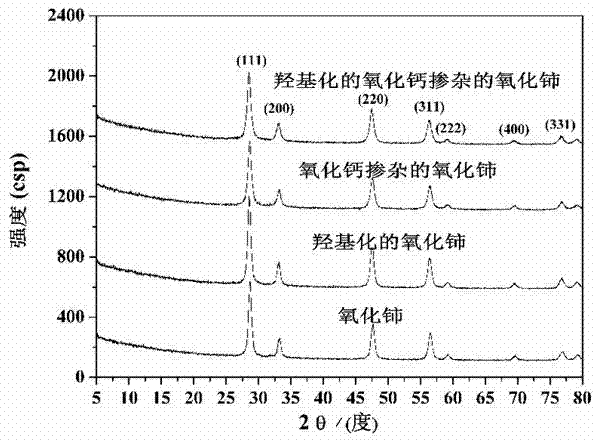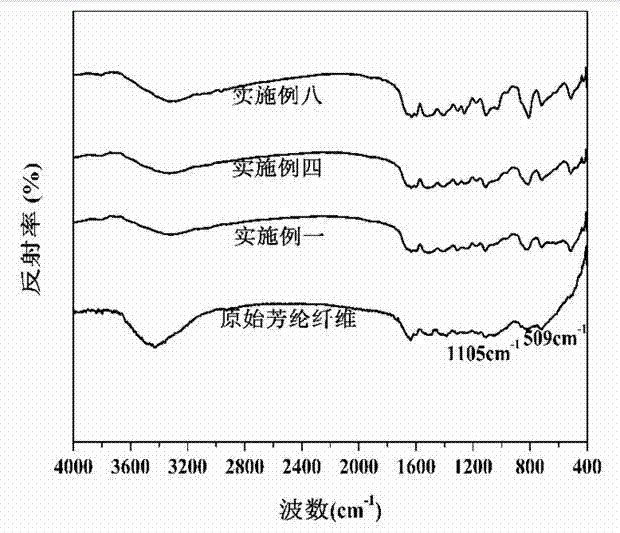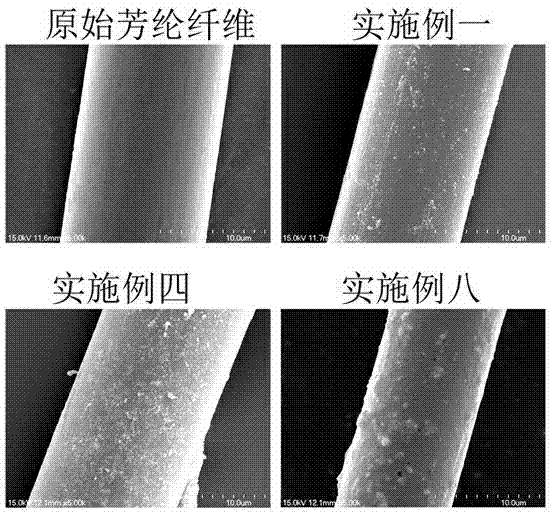Aramid fiber coated with inorganic nanoparticles on surface and preparation method thereof
A technology of inorganic nanoparticles and aramid fibers, applied in the directions of inorganic chemistry, fiber type, fiber treatment, etc., can solve the problems of low activity and poor UV resistance of aramid fibers, and achieve simple operation, wide UV absorption range, long-term good usability
- Summary
- Abstract
- Description
- Claims
- Application Information
AI Technical Summary
Problems solved by technology
Method used
Image
Examples
Embodiment 1
[0027] 1. Preparation of Aramid Fibers Covered with Inorganic Nanoparticles
[0028] (1) 0.5g para-aramid fiber (Kevlar-49, diameter 12um, density 1.43g / cm 3 , produced by DuPont, USA) were immersed in acetone, petroleum ether, and deionized water, respectively, and refluxed for 3 hours each; after cleaning, the fibers were taken out and dried at 80°C for 12 hours to obtain clean aramid fibers, which were denoted as KF.
[0029] (2) Stir and dissolve 10.5g of sodium hydroxide in 120mL of ethanol to obtain an ethanol solution of sodium hydroxide; immerse 0.1g of the KF fiber obtained in step (1) into the ethanol solution of sodium hydroxide, and reflux for 5 hours; After the reaction is finished, the fibers are washed with water and dried to obtain fibers with amino groups on the surface.
[0030] (3) Under the protection of nitrogen atmosphere, take 0.1g of aramid fibers with amino groups obtained in step (2), add 30mL of γ-glycidyl etheroxypropyltrimethoxysilane, and 150mL o...
Embodiment 2
[0038] 1. Preparation of Aramid Fibers Covered with Inorganic Nanoparticles
[0039] (1) 0.5g para-aramid fiber (Kevlar-49, diameter 12um, density 1.43g / cm 3 , produced by DuPont, USA) were immersed in acetone, petroleum ether, and deionized water, respectively, and refluxed for 3 hours each; after cleaning, the fibers were taken out and dried at 80°C for 12 hours to obtain clean aramid fibers, which were denoted as KF.
[0040] (2) Stir and dissolve 14.6g of sodium hydroxide in 120mL of ethanol to obtain an ethanol solution of sodium hydroxide; immerse 0.1g of the KF fiber obtained in step (1) into the ethanol solution of sodium hydroxide, and reflux for 3 hours; After the reaction is finished, the fibers are washed with water and dried to obtain fibers with amino groups on the surface.
[0041] (3) Under the protection of nitrogen atmosphere, take 0.1g of aramid fibers with amino groups obtained in step (2), add 20mL of γ-glycidyl etheroxypropyltrimethoxysilane, and 180mL o...
Embodiment 3
[0048] 1. Preparation of Aramid Fibers Covered with Inorganic Nanoparticles
[0049] (1) 0.5g para-aramid fiber (Kevlar-49, diameter 12um, density 1.43g / cm 3 , produced by DuPont, USA) were immersed in acetone, petroleum ether, and deionized water, respectively, and refluxed for 3 hours each; after cleaning, the fibers were taken out and dried at 80°C for 12 hours to obtain clean aramid fibers, which were denoted as KF.
[0050] (2) Stir and dissolve 14.7g of potassium hydroxide in 110mL of ethanol to obtain an ethanol solution of potassium hydroxide; immerse 0.1g of the KF fiber obtained in step (1) into the ethanol solution of potassium hydroxide, and reflux for 5 hours; After the reaction is finished, the fibers are washed with water and dried to obtain fibers with amino groups on the surface.
[0051] (3) Under the protection of nitrogen atmosphere, take 0.1g of aramid fibers with amino groups obtained in step (2), add 30mL of γ-glycidyl etheroxypropyl trimethoxysilane, a...
PUM
| Property | Measurement | Unit |
|---|---|---|
| Diameter | aaaaa | aaaaa |
| Density | aaaaa | aaaaa |
| Surface energy | aaaaa | aaaaa |
Abstract
Description
Claims
Application Information
 Login to View More
Login to View More - R&D
- Intellectual Property
- Life Sciences
- Materials
- Tech Scout
- Unparalleled Data Quality
- Higher Quality Content
- 60% Fewer Hallucinations
Browse by: Latest US Patents, China's latest patents, Technical Efficacy Thesaurus, Application Domain, Technology Topic, Popular Technical Reports.
© 2025 PatSnap. All rights reserved.Legal|Privacy policy|Modern Slavery Act Transparency Statement|Sitemap|About US| Contact US: help@patsnap.com



